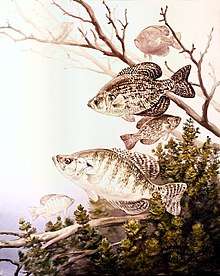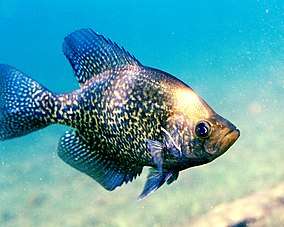Crappie
Crappies (/ˈkrɒpi, ˈkræpi/)[3][4] are a genus, Pomoxis, of North American fresh water fish in the sunfish family Centrarchidae. Both species in this genus are popular pan fish.
| Crappie | |
|---|---|
 | |
| Black (top) and white crappie (P. nigromaculatus & P. annularis) | |
| Scientific classification | |
| Kingdom: | Animalia |
| Phylum: | Chordata |
| Class: | Actinopterygii |
| Order: | Perciformes |
| Family: | Centrarchidae |
| Subfamily: | Centrarchinae |
| Genus: | Pomoxis Rafinesque, 1818[1] |
| Type species | |
| Pomoxis annularis Rafinesque, 1818[1] | |
| Synonyms[2] | |
|
Hyperistius Gill, 1864: | |
Etymology
The genus name Pomoxis literally means ‘sharp cover’, referring to the fish's spiny gill covers (opercular bones).[5] It is composed of the Greek poma (πῶμα, ‘cover’) and oxys (ὀξύς, ‘sharp’).[6]
The common name (also spelled croppie[7] or crappé[8]) derives from the Canadian French crapet, which refers to many different fishes of the sunfish family. Other names for crappie are papermouths, strawberry bass, speckled bass or specks (especially in Michigan), speckled perch, white perch[9], crappie bass, calico bass (throughout the Middle Atlantic states and New England),[10] and Oswego bass.[11]
In Louisiana, it is called sacalait[12] (Cajun French: sac-à-lait, lit. 'milk bag'),[13] seemingly an allusion to its juicy white flesh or silvery skin.[14][15] The supposed French meaning is, however, folk etymology, because the word is ultimately from Choctaw sakli, meaning "trout".[12]
Species
The currently recognized species in this genus are:[16]
- White crappie – P. annularis Rafinesque, 1818
- Black crappie – P. nigromaculatus (Lesueur, 1829)
Biology
Both species of crappie as adults feed predominantly on smaller fish species, including the young of their own predators (which include the northern pike, muskellunge, and walleye). They have diverse diets, however, including zooplankton, insects, and crustaceans.[17][18] By day, crappie tend to be less active and will concentrate around weed beds or submerged objects, such as logs and boulders. They feed during dawn and dusk, by moving into open water or approaching the shore.[19][20]
Fishing

The Pomoxis species are highly regarded pan fish and are often considered to be among the best-tasting freshwater fish. Because of their diverse diets, crappie may be caught in many ways, including casting light jigs, trolling with minnows or artificial lures, using small spinnerbaits, or using bobbers. Crappies are also popular with ice-anglers, as they are active in winter.[19][20][21] The current all-tackle fishing world record for a black crappie is 2.47 kg (5.4 lb) and for a white crappie is 2.35 kg (5.2 lb).[22][23]
Angling
| Fly fishing targets |
|---|
| See also |
Angling for crappie is popular throughout much of North America. Methods vary, but among the most popular is called "spider rigging", a method characterized by a fisherman in a boat with many long fishing rods pointing away from the angler at various angles like spokes from a wheel.[24] (Spider rigging is not permitted on some waters. In Minnesota, for example, a fisherman may use only one rod during the open water season.) Anglers who employ the spider rigging method may choose from among many popular baits. Some of the most popular are plastic jigs with lead jig heads, crankbaits or live minnows.[25] Many anglers also chum or dump live bait into the water to attract the fish to bite their bait. Crappies are also regularly targeted and caught during the spawning period by fly fishermen, and can be taken from frozen ponds and lakes in winter by ice fishing.
Commercial fishing
Before state fisheries departments began to implement more restrictive, conservation-minded regulations, a great number of crappies, especially in the Mississippi River states, were harvested commercially in the 19th and early 20th centuries. At one point the annual crappie catch sold at fish markets in the United States was reported to be approximately three million pounds.[26]
A commercial fishery for crappies existed at Reelfoot Lake in Tennessee until 2003. It was one of the few commercial fisheries for crappies in recent decades.
Fishing records
By information from International Game Fish Association IGFA the most outstanding records:[27]
- Black crappie: a 2.47 kg (5.4 lb) fish caught on 1 May 2020 by Zachariah Williams from Happy Valley Pond in West Columbia,SC US [28]
- White crappie: a 2.35 kg (5.2 lb) fish caught on 31 July 1957 by Fred Brigh in Water Valley, Mississippi, US
References
- Eschmeyer, W. N.; R. Fricke & R. van der Laan (eds.). "Pomoxis". Catalog of Fishes. California Academy of Sciences. Retrieved 24 May 2020.
- Eschmeyer, W. N.; R. Fricke & R. van der Laan (eds.). "Centrarchidae genera". Catalog of Fishes. California Academy of Sciences. Retrieved 24 May 2020.
- "Crappie". American Heritage Dictionary (4th ed.). Archived from the original on 26 September 2005. Retrieved 29 June 2006.
- "Crappie". Merriam-Webster Online Dictionary. Retrieved 29 June 2006.
- Ross, Stephen T.; Brenneman, William Max (2001). The Inland Fishes of Mississippi. Univ. Press of Mississippi. p. 436. ISBN 978-1-57806-246-1.
Pomoxis: sharp opercle, in reference to the opercle bone ending in two spines
- Wallus, Robert; Simon, Thomas P. (2008). Reproductive Biology and Early Life History of Fishes in the Ohio River Drainage. 6. CRC. p. 355. ISBN 978-1-4200-0361-1.
Pomoxis, Greek: poma, “lid, cover” and oxys, “sharp,” alluding to the opercles ending in two flat points instead of an ear flap
- "croppie". Merriam-Webster Dictionary.: "variant of crappie"
- Murray, James Augustus Henry; et al. (1893). A New English Dictionary on Historical Principles. Clarendon Press. p. 1141.
Crappie. U.S. Also crappé, croppie. A species of sunfish, Pomoxys annularis
- "Louisiana Fisheries - Fact Sheets". www.seagrantfish.lsu.edu. Retrieved 6 March 2019.
- Massachusetts Wildlife
- Schultz, Ken. Ken Schultz's Field Guide to Freshwater Fish. Hoboken: John Wiley & Sons, 2010.
- "sacalait". Merriam-Webster Dictionary. "Louisiana French sac-à-lait, by folk etymology (influence of French sac bag, French à to, for, and French lait milk) from Choctaw sakli trout "
- Smith, Hugh M. (1904). "Common Names of the Basses and Sun-fishes". Report of the Commissioner. Gov't Printing Office: 357.
The euphonious French name sac-à-lait (bag of milk), which is heard in the lower Mississippi Valley and now apparently is applied to other centrarchids as well as to P. annularis, to which it was originally given, has been corrupted to "suckley perch" in Louisiana near New Orleans.
- Bulletin. Louisiana Dept. of Conservation. 1917. p. 9.
When properly cooked the white, flaky, juicy flesh (sac-à-lait means a “bag of milk” therefor our French-speaking population has most appropriately named this fish) has an exceptionally fine and delicate flavor.
- Louisiana Conservation Review. 9–10. 1940. p. 31.
believed to have received its name sac à lait, m., "milk bag" because of the silvery olive appearance of the fish, or because of its extraordinarily white flesh. Read's further investigations, however, revealed that the Choctaw Indian sakli, "trout"
- Froese, Rainer and Pauly, Daniel, eds. (2013). Species of Pomoxis in FishBase. February 2013 version.
- Froese, Rainer and Pauly, Daniel, eds. (2006). "Pomoxis annularis" in FishBase. March 2006 version.
- Froese, Rainer and Pauly, Daniel, eds. (2006). "Pomoxis nigromaculatus" in FishBase. March 2006 version.
- "Comprehensive Report Species – Pomoxis annularis". NatureServe Explorer. Retrieved 29 June 2006.
- "Comprehensive Report Species – Pomoxis nigromaculatus". NatureServe Explorer. Retrieved 29 June 2006.
- "Black Crappie". Florida Museum of Natural History Ichthyology Department. Archived from the original on 27 July 2006. Retrieved 29 June 2006.
- IGFA World Record: Black Crappie – (Pomoxis nigromaculatus) Archived 29 October 2018 at the Wayback Machine
- IGFA World Record: White Crappie – (Pomoxis annularis) Archived 10 July 2018 at the Wayback Machine
- "Super Crappie Systems". In-Fisherman. Archived from the original on 22 December 2006. Retrieved 23 February 2007.
- Crappie Fishing Educational Fishing Information for Crappie. Retrieved 2013-07-24
- "Fisheries." The New International Encyclopedia. 2nd ed. New York: Dodd, Mead and Co., 1930.
- "IGFA World Records". International Game Fish Association. Retrieved 1 November 2015.
- "Looking At The World Record Crappie (White And Black)". Premier Angler. Retrieved 28 March 2020.
Further reading
- Ellis, Jack (1993). The Sunfishes-A Fly Fishing Journey of Discovery. Bennington, VT: Abenaki Publishers, Inc. ISBN 0-936644-17-6.
- Rice, F. Philip (1964). America's Favorite Fishing: A Complete Guide to Angling for Panfish. New York: Harper Row.
- Rice, F. Philip (1984). Panfishing. New York: Stackpole Books. ISBN 0-943822-25-4.
- Malo, John (1981). Fly-Fishing for Panfish. Minneapolis, Minnesota: Dillon Press Inc. ISBN 0-87518-208-9.
- Nelson, Gary; Martin, Richard; Sutton, Keith (1991). Panfishing. Minneapolis, MN: North American Fishing Club. ISBN 0-914697-37-4.
| Wikimedia Commons has media related to Pomoxis. |